Related Research Articles

The Australian Kelpie, or simply Kelpie, is an Australian sheepdog capable of mustering and droving with little or no guidance. It is a medium-sized dog and comes in a variety of colours. The Kelpie has been exported throughout the world and is used to muster livestock, primarily sheep, cattle and goats.

The German Shepherd, also known in Britain as an Alsatian, is a German breed of working dog of medium to large size. The breed was developed by Max von Stephanitz using various traditional German herding dogs from 1899.

The Border Collie is a British breed of herding dog of the collie type of medium size. It originates in the region of the Anglo-Scottish border, and descends from the traditional sheepdogs once found all over the British Isles. It is kept mostly as a working sheep-herding dog or as a companion animal. It competes with success in sheepdog trials. It has been claimed that it is the most intelligent breed of dog.
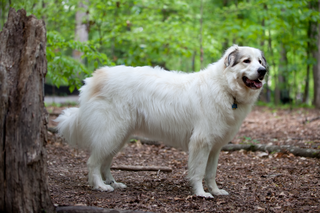
The Pyrenean Mountain Dog or Chien de Montagne des Pyrénées is a French breed of livestock guardian dog; in France it is commonly called the Patou. It originates from the eastern or French side of the Pyrenees Mountains that separate France and Spain and is recognised as a separate breed from the Mastín del Pirineo or Pyrenean Mastiff from the Spanish side of the mountains, to which it is closely related.

The Swedish Vallhund, also known as the Västgötaspets and Swedish cow dog, is a breed of dog native to Sweden. The breed's name, Vallhund, when translated into English, means herding dog, as the Swedish Vallhund was originally bred as a drover and herder of cows over 1,000 years ago. In 1942, the dog came close to extinction, but careful breeding and publicity by Swedish national Björn von Rosen and K. G. Zettersten managed to revive the breed in popularity and save it from its likely end. In 1943, the Swedish Kennel Club recognized the Swedish Vallhund as a breed, and officially categorized the Swedish Vallhund as "the Västgötaspets" for Västergötland, the province in which their revival took place. Since then, the breed has been recognized by, and bred in, over ten countries and has gained some popularity.

A herding dog, also known as a stock dog or working dog, is a type of dog that either has been trained in herding livestock or belongs to one of the breeds that were developed for herding. A dog specifically trained to herd sheep is known as a sheep dog or shepherd dog, and one trained to herd cattle is known as a cattle dog or cow dog.

Collies form a distinctive type of herding dogs, including many related landraces and standardized breeds. The type originated in Scotland and Northern England. Collies are medium-sized, fairly lightly-built dogs, with pointed snouts. Many types have a distinctive white color over the shoulders. Collies are very active and agile, and most types of collies have a very strong herding instinct. Collie breeds have spread through many parts of the world, and have diversified into many varieties, sometimes mixed with other dog types.

The Pyrenean Sheepdog, the Chien de Berger des Pyrénées in French, is a small to medium-sized breed of herding dog from the Pyrenees Mountains region of France. It is found herding flocks of sheep throughout the Pyrenees alongside the much larger Pyrenean Mountain Dog which is kept as a flock guardian.
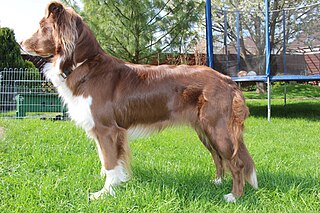
The Australian Shepherd is a breed of herding dog from the United States. The name of the breed is technically a misnomer, as it was developed in California in the 19th century. It is believed to have its origins in sheepdog breeds from northwest Spain, as well as collies imported, alongside sheep, from Australia and New Zealand; the breed reportedly took its name from this trade. Originally used solely as a herding dog, the Australian Shepherd has become one of the most popular companion dog breeds in North America.

The Puli is a small-medium breed of Hungarian herding dog known for its long, corded coat. The tight curls of the coat appear similar to dreadlocks. A similar-looking, but much larger breed – also Hungarian – is the Komondor.
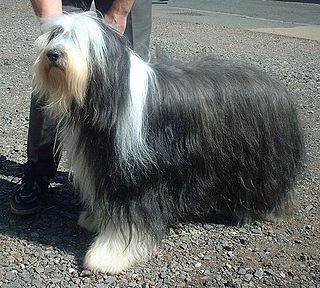
The Bearded Collie, or Beardie, is a herding breed of dog once used primarily by Scottish shepherds, but now mostly a popular family companion.
The Koolie is an Australian dog breed. The Koolie is a working or herding dog which has existed in Australia since the early 19th century when it was bred from imported British working dogs. Robert Kaleski, in an article on Cattle Dogs in the August 1903 issue of the Agricultural Gazette of New South Wales, describes the "Welsh heeler or merle, erroneously known as the German collie," as a "blue-gray dog about the size and build of a smooth-haired collie, generally with wall eyes." The British background predominated in the dogs that came to be associated with the "German collie" name.

The McNab Dog, also called the McNab Shepherd or McNab Collie is a herding dog that originated in Hopland, Mendocino County, Northern California. The McNab was bred to withstand the tough conditions found in California such as heat, burrs, foxtails, and rugged terrain. Until recently, the McNab was little known outside California, but in last three decades have seen a gain in popularity and geographic dispersal of the breed.

The Alaunt is an extinct type of dog which came in different forms, with the original possibly having existed in North Caucasus, Central Asia and Europe from ancient times.

The Welsh Sheepdog is a breed of herding dog of medium size from Wales.
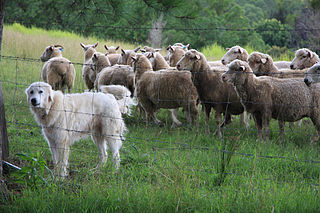
A livestock guardian dog (LGD) is a dog type bred for the purpose of protecting livestock from predators.

The Cumberland sheepdog is an extinct dog breed related to the border collie and other old working collie types. It is claimed to be one of the ancestors of the Australian shepherd and in the early part of the 20th century some Cumberland sheepdogs were being referred to as border collies and may have been absorbed into the latter breed.

The Cane Paratore is a breed of herding dog from Italy. The breed primarily exists in its traditional role in Abruzzo, its historical region of origin, having not gained popularity from outside dog fanciers.
The Welsh Grey or Old Welsh Grey was a breed of sheepdog native to Wales. It is likely now extinct.
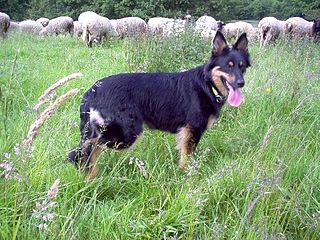
Old German herding dogs, including old German sheep dogs or old German shepherd dogs are a group of traditional types of working, herding dogs from Germany. They are landraces consisting of working strains of dog, and some of them are the types from which the modern German Shepherd Dog was developed as a standardised breed. The landraces are not recognised by the Fédération Cynologique Internationale, but some have their own standards which are for working ability, not appearance traits.
References
- ↑ Vesey-Fitzgerald, B. S. (1948). The Book of the Dog. Nicholson & Watson. p. 684.
- 1 2 3 Carpenter, B. (Fall 1994). The Shepherd's Dogge.
- ↑ "Welsh Sheep Dog". gis.net. The Border Collie Museum. Archived from the original on 2013-02-07. Retrieved 2 May 2020.
- 1 2 3 Wildhagen, P. (1977). "History of the Australian Shepherd". ASCA Yearbook. Archived from the original on 2012-02-17 – via workingaussiesource.com.
- 1 2 Hubbard, C. L. B. (1948). Dogs In Britain. Macmillan.
- ↑ Seis, C. (1996). Working Dogs: Training for Sheep and Cattle. Elsevier. p. 11.
- 1 2 McMullen, J. (1991). A Small Country Living Goes On . W W Norton. p. 137. ISBN 978-0-393-03039-6.